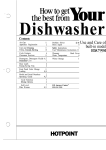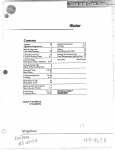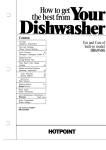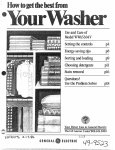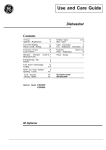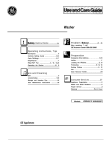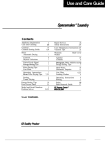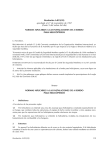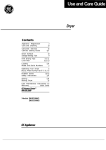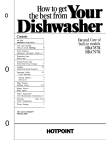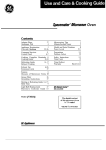Download GE DDE7606M User's Manual
Transcript
Dryer
Contents
Appliance Registration
Automatic Drying
Care and Cleaning
Consumer Services
Controls Setting Guide
Dryer Exhaust
End-of-Cycle Signal
Energy-Saving Tips
Extra Care Feature
Knits Drying Tips
Lint Filter
Loading
Model and Serial Numbers
Operating Your Dryer
Models DDE7606M
DDG7686M
DDE7608M
DDG7688M
GEAppRances
2
5
13
15
6,7
13
5
9
Perm. Press Drying Tips 5-7, 11, 12
Problem Solver
10-12
Safety Instructions
Sorting
Storing Dryer
Timed Drying
13
5
User Maintenance Instructions 13
Warranty
Back Cover
5
5-7, 11
4,9, 13
4,9
2
4,5
3,4
4,8
GEAmww Ceti@
80~6262000
If You Need Service
Help us help you...
Before using your dryer,
read this book carefully.
It is intended to help you operate and
maintain your new dryer properly.
Keep it handy for answers to your
questions.
If you don’t understand something
or need more help, write (include
your phone number):
Consumer Affairs
GE Appliances
Appliance Park
Louisville, KY40225
If you received a
damaged dryer...
Immediately contact the dealer
(or builder) that sold you the
dryer.
Save time and money.
Before you request service...
check the Problem Solver on
pages 10-12. It lists causes of
minor operating problems that
you can correct yourself.
Write down the model
and serial numbers.
You’ll find them on a label on the
front of the dryer behind the door.
These numbers are also on the
Consumer Product Ownership
Registration Card that came with
your dryer. Before sending in this
card, please write these numbers
here:
Model Number
Serial Number
To obtain a Spanish language
version of this book, call
GE Answer Center@
800.626.2000
consumer information service.
Para obtener la versi6n en
espafiol de este manual,
name a
GE Answer Center?
servicio de informaci6n
para el consumidor,
te16fono 800.626.2000.
FOR YOUR SA~TY
If you smell gas:
1, Open windows.
2. Don’t touch
electrical switches:
3. Extinguish any
open flame.
4. Immediately call
your gas supplier.
● Don’t turn electric switches
on or off because spark may
ignite the gas.
FOR YOUR SA~TY
Do not store or use
gasoline or other
flammable vapors and
liquids in the vicinity
of this or any other
appliance.
Use these numbers in any
correspondence or service calls
concerning your dryer.
All drying instruction terms in this book conform to the Care Labeling
Rule established by the Federal Trade Commission, January 1984.
2
To obtain service, see the
Consumer Services page in the
back of this book.
We’re proud of our service and
want you to be pleased. If for some
reason you are not happy with the
service you receive, here are three
steps to follow for further help.
FIRST, contact the people who
serviced your appliance. Explain
why you are not pleased. In most
cases, this will solve the problem.
NEXT, if you are still not pleased,
write all the detiils-including
your phone number—to:
Manager, Consumer Relations
GE Appliances
Appliance Park
Louisville, Kentucky 40225
FINALLY, if your problem is still
not resolved, write:
Major Appliance
Consumer Action Panel
20 North Wacker Drive
Chicago, Illinois 60606
IMPORTANT SAFETY ~STRUCTIONS
Read all instructions before usiW this appliance.
9
I
WORTMT
S~TY N~~
The California Safe Drinking
Water and Toxic Enforcement Act
requires the Governor of California
to publish a list of substances
known to the state to cause cancer,
birth defects or other reproductive
harm and requires businesses to
warn customers of potential
exposure to such substances.
Gas appliances can cause minor
exposure to four of these substances,
namely benzene, carbon monoxide,
formaldehyde and soot, caused
primarily by the incomplete
combustion of natural gas or LP
fuels. Properly adjusted dryers will
minimize incomplete combustion.
Exposure to these substances can
be minimized further by properly
venting the dryers to the outdoors.
– W-~G—To reduce the risk
of fire, electric shock, or i~ury
to persons when using your
appbc~ fo~ow basic precautions,
including the following:
c Use this appliance only for its
intended purpose as described in
this Use and Care Book.
● This dryer must be properly
installed and located in
accordance with the Installation
Instructions before it is used. If
you did not receive an Instigation
Instructions sheet with your dryer,
you can obtain one by contacting
the service location nearest you.
—Properly ground to conform
with all governing codes and
ordinances. FO11OW details in
Installation Instructions.
—Locate where the temperature
is above 50°F. (lO°C.) for
satisfactory operation of the
dryer control system. Do not
install or store the dryer where it
will be exposed to the weather.
—Connect to a properly rated,
protected and sized power-supply
circuit to avoid electrical overload.
—Exhausting to the outside is
STRONGLY RECOMMENDED
to prevent large amounts of
moisture and lint from being blown
into the room. Carefilly follow the
Exhausting Detaiis in the hstiation
Instructions.
● When disconnecting this
appliance pull by the plug rather
than the cord to avoid damage to
the cord or junction of cord and
plug. Make sure that the cord is
located so that it will not be stepped
on, tripped over or otherwise
subjected to damage or stress.
● Do not repair or replace any
part of the appliance or attempt
any servicing mdess specifi~ly
recommended in this Use and
Care Book or in published userrepair instructions that you
understand and have the skilk to
carry out.
~ mitimti the possibfity
of a f~ h-.
. Do not use heat to dry article
containing rubber, plastic, or
shnk mater~ (such as padded
bras, tennis shoes, galosh=, bath
ma@ ~ bik baby pan& p~c
bags, etc.) as these materiak may
melt or burn. Mso, some robber
mate-, when heated, a under
certain circumstances produce
fire by spontaneous combustion.
● Garments labeled “Dry Away
From Heat” (such as life jackets
containing =pok) must not be put
in your dryer.
s Do not wash or dry articles
that have been cleaned in, washed
in, soaked in, or spotted with
combustible or explosive substances
(such as wax, paint, gasoline,
degreasers, dry+leaning
solvents, kerosene, etc.) which
may ignite or explode. Do not use
or store such substances on/or
around your washer and/or dryer
during operation.
Any article on which you have
used a cleaning solvent, or which
contains flammable materials
●
3
(such as cleaning cloths, mops,
towels used in beauty salons,
restaurants or barber shops, etc.)
must not be placed in or near the
dryer untfi dl traces of these
flammable liquids or solids and
their times have been removed.
There are many highly flammable
items used in homes such as:
acetone, denatured alcohol,
gasoline, kerosene, some
household cleaners, some spot
removers, turpentines, waxes, wax
removers and products containing
petroleum distillates.
Q Clean the lint filter before each
load to prevent lint accumtiation
inside the dryer or in the room.
DO N~ OPERATE THE
DR~R WITHOUT T~ LINT
FILTER IN PLACE.
● -p area around and
underneath your appliance free
from the accumulation of
combustible materiab, such as
lint, paper, rags, chemicals, etc.
● Do not store items that may bum
or melt (such as clothing, paper
material, plastics or plastic
containers, etc.) on top of the dryer
during operation.
● The interior of the machine
and the exhaust duct connection
inside the dryer should be
cleaned periodically by a
qualified individual.
● Exhaust duct (see insta~ation
instructions). Use only metal
duct inside dryer or for
exhausting dryer to the outside.
minimk the possibility
of ~ury.
To
● Never reach into the dryer w~e
the drum is movi~ Wore loading,
unloading or adding cloth=, wait
until the drum has completely
stopped.
● Close supervision is necif this applimce is used by or near
children. Do not allow children to
e
Important safety Instruction
play inside, on or with this
appliance or any discarded
appliance. Dispose of discarded
apptiancm and shipping or packing
materials properly. Before
discarding a dryer, or removing
from service, remove the door
of the drying compartment.
c Keep all laundry aids (such
as detergents, bleaches, fabric
softeners, etc.) out of the reach of
children, preferably in a locked
cabinet. Observe all warnings on
container labels to avoid personal
injury.
● Keep the floor around your
appliances clean and dry to reduce
the possibility of slipping.
● Do not dry fiberglass articles in
your dryer. Skin irritation could
result from the remaining glass
particles that may be picked up
by clothing during subsequent
dryer uses.
. The laundry process can reduce
the flame retardancy of fabrics. To
avoid such a result, the garment
(continued)
manufacturer’s care instructions
should be followed very carefully.
● Never climb on or stand on the
dryer top or door.
s Do not tamper with controls.
$ To minimize the possibility
of electric shock, unplug this
appliance from the power supply
before attempting any maintenance
or cleaning (except the removal and
cleaning of the lint filter). N~E:
Turning the Cycle Selector knob
to an OFF position does NOT
disconnect the appliance from
the power supply.
c Do not operate this appliance
if it is damaged, malfunctioning,
partially disassembled, or has
missing or broken parts, including
a damaged cord or plug.
● If yours is a gas dryer, it is
equipped with an automatic electric
ignition and does not have a pilot
light. DO NOT ATTEMPT ~
LIGHT WITH A MATCH. Burns
may result from having your hand
in the vicinity of the burner when
the automati; ignition may turn on.
Dryer-applied fabric
softeners or anti-static
conditioners
You may wish to soften your
laundered fabrics or reduce the
static electricity in them. We
recommend you use either a
fabric softener in the wash cycle,
according to the manufacturer’s
instructions for those products, or
try a dryer-added product for
which the manufacturer gives
written assurance on the package
that their product can be safely
used in your dryer.
Service or performance problems
caused by the use of these products
are the responsibility of the
manufacturers of those products
and are not covered under the
warranty of this appliance.
SAVE THESE
INSTRUCTIONS
How to operate your dryer
WA~ING—To reduce the risk of fire. electric shock. or iniurv to ~ersons,
read the IMPORTANT SAFETY INSTRUCTIONS before o~erating this appliance.
had Your Dryer Properly
● Clean the lint filter each time the
dryer is used. Always be sure the
lint filter is in place. Don’t use the
dryer without it.
● Good sorting for the dryer begins
at the washer. Generally, if clothes
are sorted right for washing, they’re
sorted right for drying. See page 8
for sorting help. (If you do mix
various types of fabrics in your
load, set the controls for the
lighter-weight fabrics and remove
when dry. Reset controls for the
remaining heavier fabrics. )
4
Set the Controls
See the Controls Setting Guide
on pages 6 and 7.
.—
What is the difference
between Mined &
Automatic drying?
~F.brie Care Selections
Push a button to select the proper heat for your load.
Should be used with cycles indicated
Automatic,
Perm Press and
Automatic
Knits Cycles
Regular Cycle
Fabric Care
Selections
Cottons
Hiah Heat
Perm Press
Medium Heat
Knits/Delicates
Low Heat
Fluff
No Heat
//’
Timed
Cycles
●
●
I
●
●
●
●
●
~ Extra Care Cycle
(Operates only with Automatic,
Perm Press& Knits Cycles. )
Turn to ON if desired. To minimize
wrinkles set in the clothes, the Extra
Care cycle provides approximately
15 minutes of no-heat tumbling
after the clothes are dry.
Use End-of-Cycle Signal. Signal
will sound at five-minute intervals
to remind you to remove the clothes.
End-of-Cycle Signal
(Operates with any cycle.)
I
●
MED
@ Select End of Cycle Signal, if
desired. (See below. )
~ Turn Cycle Selector to desired
cycle setting. The selector may be
turned in either direction.
~ Press PUSH TO START button
to start dryer. (Opening the door
during operation stops the dryer. To
re-start, close the door and press
the START button. )
Timed Drying
When using the TIMED CYCLES,
you select the number of minutes
you wish the dryer to run and it
turns off at the end of this time
period.
Automatic Drying
When using the Automatic Cycles,
the Electronic Sensor Control .p:~
system continually senses the ~.. L(
~~“Wel%e@
determines when they a;e dried to
your pre-selected setting, and
terminates the cycle automatically.
Refer to the CONTROLS SETTING
GUIDE for recommended settings.
The Cycle Selector will not advance
until clothes have reached a certain
degree of dryness.
Dryness selections guide for
the automatic cycles
Set to Middle Position
,,,
,,” s OFF.
Polyester Knits &
Permanent Press
drying tips
● DO NOT OVERLOAD—
Garments being dried or
dewrinkled should tumble freely.
●
For most normal loads
Set toward MORE DRY
REMOVE CLOTHES
PROM~LY—To help prevent
wrinkling, remove from the dryer
promptly at the end of the drying
cycles.
●
The Signal control can be set
anywhere between OFF and
LOUD, depending on desired
sound level. The signal will sound
just before the end of the cycle to
remind you to remove the clothes.
To stop signal while sounding, turn
Signal control to OFF or advance
Cycle Selector to OFF.
The Signal should always be used
when drying Polyester Knits or
Permanent Press items which
should be removed as soon as the
dryer stops to help prevent setting
of wrinkles.
The signal should also be used with
the Extra Care Cycle.
PLACE ON HANGERS—
Permanent Press and Polyester
Knit garments look best if placed
on hangers after drying.
●
For loads that include heavyweight fabrics.
● If you desire to remove more
moisture.
●
Set toward LESS DRY
For lightweight fabric loads.
If you desire to remove less
moisture.
● For very small loads.
●
●
5
—
Controls Setting Guide for different fabrics and loads
had
Fabric Care/
Drying Sel~tion*
Cycle
Cycle Setting
Cottons & Linens
Cottons
High Heat
Automatic Regular Cycle
or
Timed Cycle
See Dryness Selection Guide on
page 5.
Set at REGULAR for dry; at
DAMP-DRY for ironing,
Permanent Press, Treated Cottons,
Blends with Cotton
Perm Press
Medium Heat
Automatic Perm Press
and Knits Cycle
Timed Cycle
See Dryness Selection Guide on
page 5.
DE-WRINKLE setting to de-wrinkle
garments that have not been washed.
Automatic Perm Press
and Knits Cycle
See Dryness Selection Guide on
page 5.
Synthetics—Polyester, Nylon,
Acrylic Knits and Woven Fabrics
Sturdy
Delicate
Perm Press
Medium Heat
Knits/Del icates
Low Heat
Silks and Wools, Blends including
Silks and Wools
Knits/Delicates
Low Heat
Automatic Perm Press
and Knits Cycle
Set toward LESS DRY. See Dryness
Selection Guide on page 5.
Rayon and Acetate
Knits/Del icates
Low Heat
Automatic Perm Press
and Knits Cycle
Set toward LESS DRY. Sec Dryness
Selection Guide on page 5.
Down-filled garments, if machine
washing and drying are
recommended.
Cottons
High Heat
Automatic Regular Cycle
Baby Clothes—Sturdy: Diapers,
Nightgowns, Shirts, Pads, Sheets,
Receiving Blankets, Coveralls. See
Special Instructions.
Cottons
High Heat
Automatic Regular Cycle
Baby Clothes—Delicate
Knits/Delicates
Low Heat
Automatic Perm Press
and Knits Cycle
Set toward LESS DRY
Blankets—Wool, Part Wool,
Cotton, Electric, Synthetic. See
below under “Extra-large Items:’
Cottons
High Heat
Timed Cycle
Set at 20 to 25 minutes
Curtains, Slipcovers, Draperies.
DO N~ MACHINE DRY
FIBERGLASS.
Cottons
High Heat
Timed Cycle
For first setting, set at 20 minutes;
for second setting, set at 15 minutes
Chenille Bedspreads, Robes. See
below under “Extra-large Items:’
Cottons
High Heat
Timed Cycle
First setting— 20 minutes;
additional settings—5 minutes.
Rubber-coated Items, Laminated
Fabrics, Vinyl, Plastics and
Articles with Plastic Trim.
Fluff
No Heat
Timed Cycle
Set for time desired.
Bathmats and Rugs
Cottons
High Heat
Timed Cycle
First setting—20 minutes;
additional settings—5 minutes.
Extra-large Items—Queen or King
Size Sheets, Blankets or Spreads,
Sleeping Bags, Insulated Jackets or
Suits, Mattress Covers (Pads),
Quilted Bedspreads.
Permanent Press
Medium Heat
Timed Cycle
First setting—20 minutes;
second setting—15 minutes;
additional settings—5 minutes.
Pillows—Feather and Polyesterfilled (if manufacturer recommends
they be dried in a dryer). See
Special Instructions.
Cottons
High Heat
Timed Cycle
Set at 70 minutes.
*The terms High, Medium and Low Heat are those usually found on fabric care labels. For best results, follow your fabric care labels.
N~E: The Cycle Selector settings indicated above are to be used as a guide. You may find that best results are obtained for certain of your fabrics
by setting the Cycle Selector to either side of the recommended settings.
6
—
SWcial Instructions
Do not dry non-colorfast items with whites or light-colored items.
Do not overload dryer; clothes should tumble freely. Remove promptly as soon as dryer stops; place clothes on hangers to
minimize wrinkling.
Do not overload dryer; clothes should tumble freely. Remove promptly as soon as dryer stops, place clothes on hangers to
minimize wrinkling.
Dry silks and wools in your dryer [m/)1 if recommended by the garment manufacturer. Follow instructions carefully.
Tumble drying is mandatory. Down must be thoroughly dried to remove odor and prevent mildewing. Place two large, dry towels in the
dryer to improve tumbling and shorten drying time. Be sure to dry thoroughly.
IMPORTANT. If children’s sleepwear is made of Modacrylic, tumble dry only on Low/Knits. Normal Heat can damage these fabrics.
Check manufacturer’s drying instructions.
—
See above instructions.
Place in dryer with 3 or 4 dry towels which have been heated for 5 minutes. Set timer for 20 to 25 minutes. Do not set control for more than
25 minutes. Do only one blanket at a time. Remove blanket at end of cycle and block blanket back to original shape. Press binding with warm
iron. Allow to dry before storing.
Use dry towels as buffers. Set timer for 20 minutes. If items are still wet, reset for 15 minutes and check again. Items should be removed while
still damp. Place slipcovers on furniture immediately. Hang draperies and curtains so that creases will fall out. Stop dryer periodically and check
filter for excess lint. Remove and restart dryer.
Tumble on FLUFF (No Heat) setting as heat may cause alteration in shape, color and appearance of such articles
Stop dryer periodically and check filter for excess lint. Remove and restart dryer.
Special precaufi(ms must be taken for extra-large items. Set dryer for 20minute.r rhen ~heck care@/ly. Set 15 minutes for second setting, check
again; and 5 minutes for each additional setting. Make sure that article does not fill drum. Many large articles, when wet, have ample room in
dryer, but as they dry and fluff up may not have room to tumble. Check carefully every few minutes and if article is still wet or damp and fills
dryer, finish drying on line. Do not, under any circumstances operate dryer for longer times without checking. CAUTION: If large items do not
have room to tumble, the air flow maybe blocked which could result in scorching your valuable items. Many large items, like shag rugs, cannot
be dried in home size dryers. DO N~fumble dry;ackefs (onfuining Kapok. (See filter cleaning instructions above. )
—
Check ticking for holes or weak seams where feathers or filling could escape. Dry no more than one pillow at a time and set dryer for maximum
time. Stop dryer occasionally and shake pillows to redistribute filling for more even drying. Check pillows at end of drying time. If they are not
completely dry, return them to dryer and reset for more drying time. Feather pillows dry very slowly and must be dried completely to prevent
mildewing. DO N~tumble drypillow.v containing ffipok.
.{efer to Garment Manufacturers’ Care hbels
For more information on care labeling, send for “What’s New About CARE LABELS:’
For sale by the Superintendent of Documents, U.S. Government Printing Office, Washington, D.C. 20402.
7
How to soti the clothes
Normally, if you have sorted clothes correctly for washing,
you will dso have properly sorted drying loads.
Sort by surface tetiure
from
LINT PRODUCERS—such as
terry toweling and chenille—give
up lint. LINT COLLE~RS—
such as man-made fibers and
napped fabrics like velveteen and
corduroy—attract lint, and must be
dried separately.
Sort by fabric
Sort by color
from
from
from
from
from
from
In addition to sorting to reduce lint
collection, it is recommended that
fabrics of similar construction be
dried together whenever possible.
m
Sort by wei@t
Separate
Heay Items
(such as
towels)
i
from
For information on tumble drying
extra-large items and different
fabrics and loads, see pages 6 and 7.
8
How to load the
clothes
Clean the lint filter before
drying every load.
Don’t overload your dryer.
Crowded loads don’t dry efficiently
and clothes may be unnecessarily
wrintied.
Clean lint filter (see shaded area)
by putting your moistened fingers
Loads should look like this:
at the corner of filter and wiping in
a downward motion all the way
across to the other corner.
Dru} with
Permanent Press Load
Dr~m with
Cottons & Linens
Lint Filter
For additional information on lint
filter, see page 13.
Ene~y-Saving ~ps
● Sort clothes by weight so you won’t
have to run an extra cycle for one or
two heavier, slower-d-rying items.
See page 8.
● Do not overload dryer. For
efficient drying, clothes need to
tumble freely.
●
Use Automatic Drying Cycles
● Clean dryer lint filter each time
● To help prevent ironing, use Perm
you dry.
Press (Medium) or Knits/Delicates
(Low). Remove garments promptly ~ ~1~ dwer efiaustductig at ~=t
at end of drying cycle and place on
once a year. A partially clogged
hangers.
exhaust can lengthen drying time.
. Dry your clothes in consecutive
loads. ‘Using a “warm” dryer will
save energy.
whenever possible to help prevent
overdying and to save energy.
9
m
~
Questiom?
.F; UseThisfioblem Solver
—
PROBLEM
POSSIBLE CAUSE AND REMEDY
DRYER WON’T
START
. Dryer unplugged. Make sure power cord is plugged in.
. No power to dryer. Check fuses and circuit breakers to make sure dryer is getting
current. Most electric dryers use two.
● Controls improperly set. Make sure controls are set and START switch is pushed.
Opening the door during operation stops the dryer. Tore-start, close the door and push
the START switch.
. Dryer door is open. Close door securely—dryer will not run with door open.
. Circuit is overloaded. Do not operate other appliances on the same electrical outlet
or circuit while the dryer is operating.
CL~HES TAKE
~0 LONG TO DRY
● Controls improperly set. Check all controls to make sure they are correctly set for
the load you want to dry. See pages 4-7.
● Cloggd lint filter. Remove and clean filter before every load. Periodically clean area
under lint filter with vacuum cleaner. See page 13.
● Improper ducting. Make sure dryer is ducted in accordance with Installation
Instructions.
. Obstruction in exhaust ducting. Make sure ducting is clean and free of obstruction;
make sure damper in outside wdl cap operates easily. If flexible ducting is used, be
sure it is not kinked and is properly installed according to Installation Instructions.
. Blown fises or tripped circuit breakers. Check household fises or circuit breakers.
Most electric dryers use two. It is possible for one to be blown or tripped and the dryer
still tumble without heat.
●
Improper sorting. Do not mix heavy, hard-to-dry items with lightweight articles.
● Large loads of moisture-holding fabrics, such as beach towels, take a long time to
remove moisture.
. Too many items in dryer. Dry only one washer load at a time. Do not combine loads.
● Too few items in dryer. If drying only one article, add two more similar articles, even
if dry, to insure proper tumbling.
SHWNKAGE,
GENERAL
● Some fabrics wi~ shrink whether machine washed and tumble drid or washed by hand
and drip dried; others may be safely washed but will shrink in a dryer. Follow Garment
Manufacturers’ Care Labels exactly. If in doubt, do not machine wash or tumble dry.
10
PROBLEM
POSSIBLE CAUSE AND REMEDY
SHMNKAGE,
● Relaxation shrinkage can occur in knit fabrics that have been improperly stretched
and elongatd by the manufacturer. When this occurs, garment maybe pressed back into
shape after each wash and dry cycle.
KNITS
● Progr=sive or delayed shrinkage is caused when starch or sizing (in some fabrics) is
gradually removed by laundering. Maybe noticd in older garments that have been
laundeti many times without previous-e. ht m for Rel~tion S- tie.
s Shrinkage camed by overheating occurs in certain knit fabrics that have been heatshaped. When washing, drying or ironing temperatures exceed the temperatures used to
shape set, shrinkage may occur. This cannot be corrected, but it can be prevented by
washing in cold or warm water; drying on low heat.
WWNKLINGIN
PERMANENT PRESS
AND “NO-IRON”
ITEMS
● Leaving clothes in dryer after tumbling stops. Remove clothes promptly and hang
them immediately.
●
Too many items in dryer. Dry only one washer load at a time. Do not combine loads.
● Tw few items in dryer. If drying only one article, add two or more similar articles, even
if dry, to insure proper tumbling.
. Improper loads. Avoid laundering heavy Permanent Press items, such as work clothes,
with lighter Permanent Press items, such as shirts or blouses. Do not wash or dry
Permanent Press with regular laundry.
s Too many clothes in washer. Items must have room to move freely. Permanent Press
loads should always be smaller than regular loads.. .no more than medium loads.
● Use of incorrect wash and dry cycles. Use Permanent Press Wash Cycle which provides
a cool-down rinse to minimize wrinUing. Also, use Permanent Press Dry Cycle.
●
Incorrect water level. Use large water level for medium load; medium level or half full
for small load.
●
Washing repeatiy in too hot water. Wash in cool or ~ water with plenty of detergent.
11
The Roblem Solver (continued)
PROBLEM
POSSIBLE CAUSE AND REMEDY
WMNKLING IN
PERMANENT PRESS
AND “NO-IRON”
ITEMS (continued)
●
Accumulation of lime scale due to use of carbonate detergents. If you must use a
non-phosphate detergent, avoid the use of a high-carbonate detergent.
Q Failure to use fabric softener. Proper use of fabric softener will minimize wrinkling.
To remove wrin~es:
Retumble on “Permanent Press” setting.
. Rerinse and dry on “Permanent Press” setting.
● Ifunsuccessfu], retumble on
●
high heat for 10-12 minutes and hang immediately.
. Iron carefully.
. Send to dry cleaners for pressing.
● Some wrinties may remain which cannot be removed:
*N~E: If you follow good laundry procedures and Permanent Press clothes still come
out wrin~ed, the finish may not be good quality. Also, in permanent press synthetic/
cotton blends, the cotton portion of the fabric can eventually wear away leaving only the
synthetic. Since it’s the cotton portion which is treated for Permanent Press, a loss or
decrease of Permanent Press performance will result.
If you need more help.. call, toll free:
GE hswer Center”
8W.62&2~
consumer information service
12
Care and Cleaning
USER MAINTENANCE
INSTRUCTIONS
God dryer care
The Drum. Porcelain enamel
drum is rust-resistant and requires
no special care.
The Exterior. Wipe off any spills or
washing compounds. Wipe or dust
with damp cloth. Try not to strike
the surface with sharp objects.
The Lint Filter. Wipe lint filter
before every use as described on
page 9. Periodically lint filter
should be removed and suction
hose from vacuum cleaner should
be inserted into the opening.
See below.
CAUTIONS:
Q Before having your electric dryer
connected in your new residence,
be sure your licensed electrician
confirms that the supply voltage
matches the voltage specified on
the rating plate.
● Dryer control panel and finishes
may be damaged by some laundry
pretreatment soil and stain remover
products if such products are
sprayed on or have direct contact
with the dryer.
Apply these pretreatment products
away from the dryer. The fabric
may then be washed and dried
normally. Damage to your dryer
caused by pretreatment products is
not covered by your warranty.
Do not obstruct the flow of
combustion and ventilating air.
Dryer Exhaust: Inspect and clean
the dryer exhaust ducting at least
once a year.
To store dryer: For short period of
time, disconnect power supply and
clean lint filter.
Do not store dryer where it will be
exposed to the weather.
13
14
Wdll Be There
With ‘the purchase of your new GE appliance, receive the
assurance that if you ever need information or assistice
from GE, we’ll be there. Ml you have to do is cdl—toll-free!
GEAnswer Centera
800.6262000
In-Home Repak
Service
Service Contracts
800-GE-CARES
You can have the secure feeling that
GE Consumer Service wfll stall be
there after your warranty expires. Purchase a GE contract while your warranty is stil in effect and you’ll receive
a substantial discount. With a mdtipleyear contract, you’re assured of future
service at today’s prices.
AGE Consumer Service professional
wfll provide expert repair service,
scheduled at a time that’s convenient
for you. Many GE Consumer Service
company-operated locations offer you
service today or tomorrow, or at your
convenience (7:00 a.m. to 7:00 p.m.
weekda~ 9:00 a.m. to 2:00 p.m. Saturdays). Our factory-trained technicians
know your applimce inside and out—
so most repairs can be handed in just
one visit.
Whatever your question about any GE
major appliance, GE Answer Cente@
information service is available to
help. Your cdl—and your question—
will be answered prompdy and
courteously And you can cdl any
time. GE Answer Cente@ service is
open 24 hours a day 7 da~ a week.
800-626-~4
Telecommunication Detice for the Deaf
P- andAccessories
800-626-2002
hdividu~ qutiled to service their
own appliances can have needed
parts or accessories sent directiy to
their home, free of shipping charge!
The GE parts sytem provides access
to over 47,000 parts.. and dl GE
Genuine Ren4 Parts are fully
wamted. WSA, Maste~ard and
Discover cards are accepted.
User maintenance instructions
contained in this boo~et cover p~
durea intended to be performed by
any user. Other servicing genedy
shodd be referred to qutied service personrtel. Caution must be
exercised, since improper servicing
may muse unsafe operation.
For Customers W&h
Special Needs...
800.626.2000
Upon request, GE wdl provide Braille
controls for a variety of GE appliances,
and a brochure to assist in planning a
barrier-free kitchen for persons with
limited mobflity To obtiin these items
free of charge, cdl 800.626.2000.
Consumers with impaired hearing
who have access to a TDD
or s~eech
,
or a conventional teletypewriter may
cdl 800-TDD-GEAC (80i-833-4322) ‘
to request information or service.
YOUR GE AUTOMATIC CLOTHES DRYER
WARRANTY
Save proof of original purchase date such as your sales slip or cancelled check to establish warranty period.
WHAT IS COVERED
FULL ONE-YEAR WARRANTY
For one year from date of original
purchase, we will provide, free of
charge, parts and service labor
in your home to repair or replace
any part of the dryer that fails
because of a manufacturing
defect.
This warranty is extended to
the original purchaser and any
succeeding owner for products
purchased for ordinary home use
in the 48 mainland states, Hawaii
and Washington, D.C. In Alaska the
warranty is the same except that it
is LIMITED because you must pay to
ship the product to the service shop
or for the service technician’s travel
costs to your home.
All warranty service will be provided
by our Factory Service Centers or
by our authorized Customer Care”
servicers during normal working
hours.
Look in the White or Yellow Pages
of your telephone directory for
GENERAL ELECTRIC COMPANY,
GENERAL ELECTRIC FACTORY
SERVICE, GENERAL ELECTRICHOTPOINT FACTORY SERVICE or
GENERAL ELECTRIC CUSTOMER
CARE” SERVICE.
WHAT IS N~ COVERED
● Service trips to your home to
teach you how to use the product.
Read your Use and Care material.
If you then have any questions
about operating the product,
please contact your dealer or our
Consumer Affairs office at the
address below, or call, toll free:
GE Answer Center@
800.626.2000
consumer information service
● Replacement of house fuses or
resetting of circuit breakers.
. Failure of the product if it is used
for other than its intended purpose
or used commercially.
● Damage to product caused
by accident, fire, floods or acts
of God.
WARRANTOR IS NOT RESPONSIBLE
FOR CONSEQUENTIAL DAMAGES.
. Improper installation.
If you have an installation problem,
contact your dealer or installer.
You are responsible for providing
adequate electrical, exhausting
and other connecting facilities.
Some states do not allow the exclusion or limitation of incidental or consequential damages, so the above limitation or exclusion
may not apply to you, This warranty gives you specific legal rights, and you may also have other rights which vary from state to state.
To know what your legal rights are in your state, consult your local or state consumer affairs office or your state’s Attorney General.
Warrantor: General Electric Company
If further help is needed concerning this warranty, write:
Manager—Consumer Affairs, GE Appliances, Louisville, KY 40225
Pati No. 113 D5497P172
Pub. No. 49-9666
6-90
CG
DDE7606M
DDG7686M
DDE7608M
DDG7688M
















